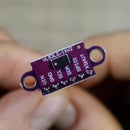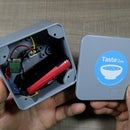Introduction: T8 Mains LED Light Teardown
Hi Everyone,
In this Instructable I’ll show you how mains voltage T8 LED light bulb is built and operates.
In the past, a T8 fluorescent bulb was very common to be seen in offices and other commercial spaces for its versatility and great light output. These days, fluorescent lamps are replaced with LEDs and the same format is still kept.
T8 stands for a standard lamp that is one inch in diameter. It is introduced in the 1930s but became really popular in the 1980s.
I’m installing such T8 LED bulbs in my home workshop and unfortunately, one of them broke in the process. Instead of tossing it in the garbage, I’ve decided to tear it open and show you how it is built.
Step 1: Remove the End Caps
To open it, I first pulled the cap on the side where it was broken and saw a wire connected to both of the terminals on the cap. I’ve cut that and I could remove the cap. On the inside I saw that there is a lot of hot glue so I knew that trying to pry it open on the other side might result in a lot of flying glass.
Instead, with my coping saw, I’ve cut through the side of the cap to get the wire exposed on the other side and cut it as well. Since the cap was also glued into place, I’ve cut it with the saw and was able to pry it open from the tube.
Step 2: Remove the Strip and Driver
At this end, the LED driver board was also glued in so with a bit more prying, I managed to release it and remove it from the light diffuser. To keep everything in place, inside the diffuser there is a channel where the LED strip is housed.
The LED strip construction is done on an aluminium backed PCB, where one wire of the AC connection is soldered on one end and it then runs along the entire length to the other side where the driver board is.
A piece of foam tape was sticked to the bottom of the driver board and after removing, I was able to reverse engineer how it worked. At first I thought that it is a standard switch mode power supply but the “transformer” looking device had only two connections and was a choke instead, where the entire driver operated as a sort of step down converter.
Step 3: How It Works
I did some digging and I was able to find a datasheet for the driver chip, whose number is LIS9413. All of the documentation on it is in Chinese but I was able to identify that this is a constant current driver chip and the example circuit in the datasheet was exactly how the driver board was build.
The AC input comes directly to the bridge rectifier and it’s output is then smoothed out by a 400V 10uF capacitor. The driver chip is powered on pin 1 directly from the high voltage output. Pin 7 is ground and pin 4 is used to set the current on the LEDs. In this case, the resistor used has a value of 2.2Ohms and it is connected between pin 4 and ground.
To connect the output of the chip to the LEDs, two pins are being used, pin 6 and 7. The choke is connected in series with the string of LEDs and a flyback diode is added in parallel to prevent the flyback voltage spike on the inductor.
In total, 126 LEDs are mounted on the strip in 42 groups of 3 parallel LEDs that are then connected in series. Since the entire assembly is still good and operates, I’ll try to find a good use for it and build a fixture for.
Step 4: Enjoy!
I hope that you found this Instructable interesting and that you managed to learn something. If you have any comments or questions, then leave them down below, don’t forget to like and subscribe to my Youtube channel and I’ll see you all in the next one.
Cheers!













